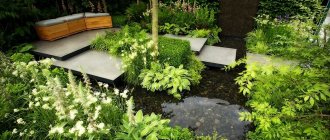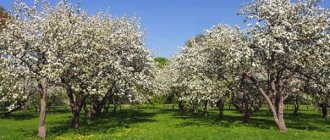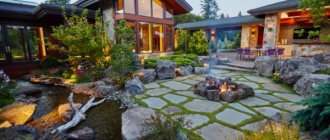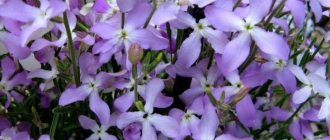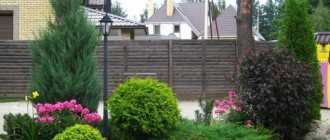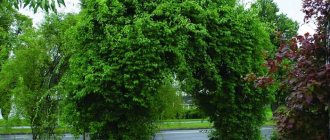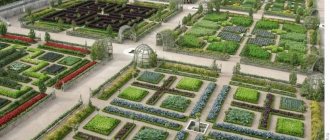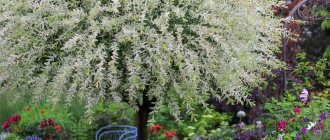Today, there are many types of plants for garden plots, which differ in height, density, appearance and other characteristics. Fast-growing conifers are also in great demand. They are mainly used for hedges, but garden compositions with their participation are often found.
Quote: The main advantage of conifers can be considered their long life span.
Among the evergreen fast-growing plants, the following varieties stand out:
- dwarf - do not gain a height of more than one and a half meters;
- medium - their height range is approximately from 5 to 17 meters;
- tall - in adulthood the tree gains more than 18 meters in height.
The maximum growth rate of any conifer variety is 0.3 meters of annual growth. Fast-growing coniferous trees for landscape design and fence construction are selected taking into account the fact that they will reach their average height in 5–6 years.
The fastest growing trees
Eucalyptus grows the fastest: in the first 3 years it can grow up to 10 m, and by the tenth year of its life it can “grow” up to 25 meters. Unfortunately, eucalyptus is not grown in most regions of Russia, since it is a tree of tropical and subtropical climates. Other tree species are suitable for Russian latitudes, which, although inferior in growth to eucalyptus, are also fast-growing.
The annual growth of birch at the peak of its development can reach 2 m, and it is considered the fastest growing tree of temperate latitudes in Russia. Birch quickly forms a crown, increases the diameter of the trunk, and in 4 years grows into a fairly large tree. The most common types of birch in Russia are silver and curly.
The second place in terms of growth intensity is occupied by white willow. You can root a small twig, and with sufficient soil moisture it will turn into a spreading tree in 5 years.
Poplar grows very quickly, especially its pyramidal forms, which form narrow, upward-pointing crowns. But one plant is of little use on a site, and in order to protect the site from the wind or create dense shade, you need to plant at least 3-4 poplars nearby.
White acacia (false acacia) is a tall tree with a spreading crown, blooming with fragrant white inflorescences from May to June. The plant belongs to the genus Robinia, and is not related to the genus Acacia, inhabitants of the southern regions, which are not characterized by rapid growth rates.
Deciduous trees also include various types of maples, elms and ash trees, as well as bird cherry and aspen. In general, all tall deciduous trees grow quite quickly until they reach an “adult” habit.
Interesting. All trees do not grow the same throughout their lives. At first, they rapidly increase in volume and height, and from about 10 years of age, the rate gradually decreases. For each plant, a decline in development occurs at a different stage of growth, but it occurs in deciduous and coniferous species almost equally.
Imported seedlings - good or bad?
Unfortunately, in large Russian cities it is almost impossible to find domestic planting material for ornamental plants. The fact is that in the current conditions, mass production of containerized conifers is still a costly, labor-intensive and risky enterprise. Accordingly, the products of European nurseries, offering an abundance of varieties at relatively low purchase prices, dominate the domestic market. But buyers are sometimes cautious and doubt the winter hardiness and reliability of “foreign” planting material. But in vain, because the main thing is not WHERE the plant is grown, but what kind it is, what its characteristic features are and what adaptation capabilities it has. Simply put, you should choose potentially winter-hardy conifer species grown in open ground. And for identification, any seedling must have a label indicating the botanical Latin name of the plant species and variety.
To make a decision on choosing a plant, it is necessary to have reliable information characterizing a specific variety (size, shape, growth rate, features of agricultural technology, etc.). The easiest way is to trust the seller, the most correct one is to get information yourself using the Internet, books and magazines. In any case, it should be remembered that many varieties of conifers for the central zone of our country are introduced (that is, unusual for a given area), and, therefore, undergo the testing stage.
Fast-growing trees for the garden
In landscaping a suburban area, you can use maples, birches and other tree species, but most often they are planted outside the fence. Typically, other crops are used within the land plot: ornamental, fruit, coniferous, medium and low-growing plants.
Deciduous decorative
Trees with an unusual crown shape and non-standard leaf color look beautiful on an open lawn. They are planted in small groups, singly, or as a background for flower beds.
Beautiful trees for the garden:
- Red maple Red Sanset – deep red leaves;
- False sycamore maple Purpurea - the underside of the leaf blade is burgundy in color, and the upper side is green;
- Ash-leaved maple “Flamingo” - newly opened leaves have a pink tint, later they become variegated;
- Norway maple Drummondii with variegated foliage;
- Tomentose linden Silver Globe - has spectacular silvery foliage;
- White poplar Nivea – the underside of the leaf blade is snow-white, when gusts of wind the crown shimmers with silver;
- Scandinavian mountain ash Magnifica - leaves are silvery-pubescent, ripen in the fall and bright red-orange clusters of berries remain on the branches for a long time.
Decorative deciduous trees are planted in the most visible places: near the gazebo, near the terrace, in the center of a flower arrangement, near an artificial pond. The place should be open or with light, openwork shade at midday. In dense shade, beautifully colored leaves lose color, and with it their elegance.
Coniferous fast-growing
Compared to deciduous trees, conifers grow much slower, but among them there are leaders. Large trees give the greatest increase in growth, and the first place is occupied by larch, Siberian and European.
Under favorable conditions, they grow 1 m per year. This is the only coniferous plant that sheds its needles for the winter: in the fall they turn yellow and fall off with the onset of frost. In winter, the bare branches of larch are not a very attractive sight, so it is not as often used in landscape design as other representatives of conifers.
Where is the best place to buy seedlings?
It is best to go for seedlings to large garden centers, nurseries or supermarkets. This recommendation is explained by the fact that large dealers with a proven reputation are able to provide optimal conditions for the transportation and storage of planting material in their sales and warehouse areas.
One more nuance: all coniferous seedlings cannot tolerate drying out of the earthen coma, and many suffer from dry air in heated rooms. This must be taken into account when storing and, if possible, avoid purchasing coniferous plants displayed in early spring in sales areas at room temperature.
It is very convenient to use the services of online stores, and when rare varieties and new items appear on the sites, you should not waste time, otherwise the scarce goods will be snatched up by the same “crazy people” as the author of this article.
Fast-growing shrubs for the garden
Along with trees, deciduous, coniferous and berry bushes are grown in summer cottages. In small areas they can be found even more often than trees, since the compactness of the crown allows you to save space. In addition, shrubs are more versatile: they are used for zoning a site, creating hedges, and being incorporated into flower arrangements and flower beds.
Coniferous fast-growing shrubs
Cossack juniper (Juniperus Sabina) grows quite quickly. It rapidly grows in width, forming dense masses. It has the ability to take root by shoots: branches that are bent and in contact with moist soil take root and produce new shoots.
Horizontal juniper (Juniperus horizontalis) does not lag behind its relative Cossack in growth rate - its annual growth is 15 cm. Rising above the ground by only 30 cm, in the horizontal plane it can cover an area of 5 m.
Advice. To quickly fill the garden, it is recommended to buy coniferous plants at 4-5 years of age, always in containers. Planting is carried out with minimal damage to the root system, due to which adaptation is quick and painless, and the plant gives good growth already in the year of planting.
Deciduous shrubs
Deciduous ornamental shrubs can change the landscape in just 2-3 years, since many of them grow very quickly. The top 6 in terms of speed of green mass growth include the following plants:
- Viburnum foliage - if the bush is not trimmed, it grows up to 3 m in height. The branches are densely leafy, blooming with white inflorescences in the first half of summer;
- Mock orange - in some areas known as jasmine, but this is a different plant. A very viable and unpretentious shrub, valued for its abundance of flowering with fragrant, loose inflorescences and rapid growth;
- Various types of summer-flowering spirea (vangutta, oakleaf, arguta, gray). It is unpretentious, frost-resistant, and easily tolerates drought. In the month of June, thin branches bend to the ground under the weight of white inflorescences, which is why the plant is sometimes called the “white bride”;
- Common viburnum - loves moist soil and is not afraid of low temperatures. The branches are weakly branched, attractive in the fall with red clusters of berries;
- Lilac - forms many shoots that stand as a solid, impenetrable wall. It is loved by many summer residents for its large fragrant inflorescences of lilac and white color;
- Cotoneaster is a dense shrub with long, downward-sloping branches; there are creeping forms. All cotoneasters grow quickly, but the variety Parkteppich stands out especially. Last year's leaves fall off only after new ones grow, so the plant can be conditionally classified as evergreen.
Berry bushes
The use of fruit-bearing fast-growing shrubs in landscaping a plot provides two advantages: edible (or medicinal) fruits and a beautiful landscape in 3-4 years. Gooseberries or currants are unlikely to be suitable for these purposes, since they do not have a high growth rate, but there are other, faster-growing species.
Comments (4)
Igor
07/08/2017 at 01:33 |
Of all the coniferous trees and shrubs listed in the article, it is best to plant juniper and Serbian pine on the site, which grow faster than other types of coniferous trees.Answer
Yulia Expert Plodogorod
03/08/2019 at 23:30 |
Hello, Igor! Yes, these trees grow quite quickly. But, in order to get a landscape design that will fully meet the tastes and needs of the gardener, you need to take into account a few more nuances, in addition to the growth rate.
To begin with, we recommend finding out what role the coniferous plant plays. For example, some gardeners plant them in order to get shade in the garden, to mark the entrance, to complement the composition, or to fill voids in the flower garden. You can also create a path border or a hedge.
When the goal is indicated, it becomes clear what size the plant should be, vigorous or dwarf. Next, among the diversity of the selected group, you need to select those representatives who will take root well in the existing conditions.
Thus, some conifers are indifferent to the composition of the soil or watering, certain trees and bushes prefer shaded areas, and some prefer only bright sun.
We recommend checking what kind of diseases and harmful insects are found on the site and reading information about how resistant the selected plant is to them.
Now you can already understand which plants from the sample reduced according to the described conditions are suitable in appearance and will quickly grow to complement the site.
Answer
Anya
03/07/2019 at 00:28 |
They say there are also special types of fertilizers for coniferous plants so that they grow and develop better. Can I have a couple of names for my Christmas trees? I want to try feeding trees with them.
Answer
Yulia Expert Plodogorod
03/09/2019 at 00:29 |
Hello, Anya! Fertilizers are usually used for young and small coniferous plants. The most important application of fertilizers is carried out in the spring. Those feedings that are applied in the summer are of an auxiliary nature.
As for mature, vigorous trees, such as spruce or pine, there is no point in feeding them. To keep them healthy and beautiful, you need to maintain the overall good condition of the soil and the area as a whole.
Small specimens require the most care, including fertilizers, especially if they are not typical for the region in which they grow.
In order for the needles to be thick and have a rich color, magnesium is required. A significant amount of calcium is required for the formation of young branches. We also recommend adding sulfur and iron to your diet. But you need to make sure that the products used do not contain chlorine.
The use of mineral mixtures, manure, droppings, and herbal tinctures is not recommended. To provide the plant with nitrogen, potassium and phosphorus, mulch the soil underneath with peat or leaf humus.
If the needles begin to acquire a yellow or red-brown tint, we recommend using stimulant drugs. For this you can use Zircon or Novosil.
If the plant looks very bad and there is a suspicion that it has begun to die, then you can try stem injections. HB-101 is suitable. The same preparation in the form of granules can be scattered around the tree trunk without digging into the soil.
In early spring, when the snow has already melted, you can use Fertika-Vesna, Bona Forte, Hera coniferous, and potassium humate. After application, the soil needs to be loosened a little. If the tree is sick or has not survived the winter well, reapply one of the products in mid- or late May.
During the summer, we recommend feeding your pet twice a month. Among the drugs you can choose Aquarin, Kristalon, Micro Mix, Agricola, Florovit. There should be a note on the packaging that the product is suitable for coniferous plants.
These products can be used until the end of summer. We do not recommend using them in the fall, especially if cold weather begins quickly in the region. If you stimulate the plant at a time when it should be preparing for dormancy, it may not survive the winter well.
Answer
Fast growing shrubs for hedges
This phrase may sound somewhat hackneyed, but you can’t do without a fast-growing shrub when creating a hedge. From it you can quickly “grow” a very dense, impenetrable fence of any height.
Free growing hedges
If the fence of plants will not be trimmed, you can select highly decorative plants. Barberry (Amur and ordinary) is a fruit-bearing shrub with berries rich in vitamins K and C. Thunberg barberry has a particularly attractive appearance with graceful, bowing branches, completely strewn with small burgundy-red leaves.
A snowberry garden is suitable for zoning the site. Its fruits in the form of white balls remain on thin branches almost all winter. It tolerates shearing easily and is unpretentious in terms of soil composition.
Advice. To fence a plot of land from the street side, thorny plants, for example, thorns and rose hips, are suitable. True, rosehip has a “habit” of growing uncontrollably, so it should immediately be allocated an area, fencing it with a border.
Molded hedges
For a trimmed green hedge, densely leafed, abundantly branching shrubs are selected, that is, those with a dense dense crown. The advantage of a molded fence is its compactness: it occupies a strictly limited space and does not block the view. Common privet, hawthorn, cotoneaster, and bush willow grow quickly and easily tolerate pruning.
Cotoneaster brilliant
Conifers are used in free-growing and shaped hedges. Thuja occidentalis grows quickly. The most unpretentious variety is “Brabant”, the annual growth of which is up to 30 cm. You can also plant a hedge of western thuja Columna and Smaragd.
Thuja Columna
Norway spruce and prickly spruce are used to create impenetrable thorny fences, and Virginia juniper is used for zoning a site.
By planting a hedge, you can combine plants of different heights and foliage colors, creating a unique landscape. Fast-growing shrubs and conifers are excellent materials for this creative work.
In the end, I would like to say that trees, just like any living beings, need care and maintenance: pruning, proper soil, protection from diseases and pests. It is not enough to simply plant a seedling and forget about it. You can find care manuals on the Internet, as well as information about means of protection against diseases (fungicides) and pests (insecticides such as Coragen, KS Expert Garden and Confidor Extra).
dizlandshafta
Evergreen conifers in the middle zone
Hopeless: cedar (Himalayan, Lebanese, Atlas), cypress, Lawson cypress, Japanese cryptomeria, metasequoia, pine (Jeffrey, Italian, Montezuma, Wallich), oriental thuja.
Risky: Canadian spruce "Konika", cypress (Nootka, blunt), Nordmann fir, pine (Weymouth, flexible, yellow, small-flowered, black), sciadopitis whorled, yew (Canadian, pointed, berry), thuja, thuja folded.
Optimally: spruce (prickly, common, Serbian), microbiota, juniper (Virginian, horizontal, Cossack, Chinese, common, rock, scaly), fir (Korean, monochrome, Sakhalin), Menzies pseudo-hemlock, pine (Banks, mountain, European cedar , Korean cedar, Siberian cedar, dwarf cedar, common, Schwerin), Canadian hemlock, western thuja.
Groups
This method involves creating compositions from several plants. Plants should be selected taking into account their ferocity. Tall shrubs should be planted in front of tall trees, and in front of which, in turn, it is better to plant low vegetation. To prevent the composition from being boring, it is better to choose plants with variegated leaves.
You can place such a group in the center of the garden. In this case, tall plants should be planted in the middle. If the group can only be seen on one side near a facade or fence, make sure that the height of the plants increases towards this structure.
When planning a group, the requirements of the plants should also be taken into account. In no case should they obscure each other. In addition, when planting plants, you should leave the necessary space between them.
Before purchasing trees for landscape design, you should know all their parameters: size, crown shape, growth rate and height.
Are you afraid of making a mistake? Then you need to make a dendroplane. Here you can accurately plan the planting of each type of plant. With this plan in hand, you can go to a garden center, which will recommend purchasing the appropriate plants.
What ornamental trees to plant on the site. We are planning to create a fruit-bearing garden
What fruit trees should be planted on the plot? Focus on your preferences and compliance with the climate zone. Once you have decided on the list of varieties that can be grown in your region, proceed directly to the choice. At the stage of organizing a garden, various aspects and parameters are taken into account.
Create a planting pattern
Before you start taking active steps, create a planting diagram on paper. Sketch a plan for the location of the seedlings.
Decide on quantity
Think about why you need fruit crops. Do you want to please yourself with fresh berries and fruits in season, are you planning to harvest or want to get a harvest for commercial purposes? How many family members will you divide the collected fruits and berries among?
If you do not expect further sale of the fruits, you should not plant 25 seedlings of the same type.
Create a list of preferences
Write a list of those representatives of the flora that you would like to see near your house first. Think about what fruits and berries you need most? What cultures don't inspire sympathy? Are you allergic to any of the plants?
Make a list in descending order of importance. Start purchasing seedlings from the first positions. At the end of the list there should be the least fit and desirable specimens.
Take into account the size of the plot
If you want to try as many fruits as possible, but the plot size is modest, use the following tricks:
Plant dwarf species. The advantage of these is their compactness and ease of maintenance. The owner will have the opportunity to feast on the fruits, despite the small territory. However, many gardeners note that columnar specimens deplete the soil more.
To get different fruits, use grafting. This technique will allow you to get branches hung with fruits of different varieties (plums, apples).
Leave enough space between plants
When planted, the seedlings are miniature and slender, and over time they grow significantly. Leave enough space between them. Consider the variety and adult size.
Choose your neighbors wisely
An important detail is the correct combination of neighboring trees. Sweet cherries pollinate better and grow in the company of their own kind. There is no point in planting one cherry tree in a garden bed.
Place the walnut away from other green spaces. It will try to destroy nearby plants. But mulberry will not bother any neighbor.
You can plant several fruit trees near your house, or start creating a whole garden. It is worthwhile to correctly calculate your strength. If the area is large, it may be better to invite a professional team.

